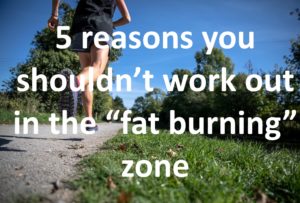We’ve all seen it. The setting on the treadmill that says “fat-burning zone.” The heart rate monitor that tells you to stay in the yellow (or whatever color yours is) zone when working out. The elliptical that limits you to a nice, conversational pace and tells you you’re not in the “fat-burning zone” if you dare to do a couple sprint intervals.
What’s the deal with the fat-burning zone?
The human body uses a mix of fuel to power your day. During a workout, you usually use both fat and carbohydrate to fuel the exercise. If you are working at a moderately uncomfortable pace, where you can still hold a conversation, but your heart rate is elevated, this is the “fat-burning” zone. Usually it is around 60-70% of your maximum heart rate.
How do I calculate heart rate fat-burning zone?
The quickest way to calculate this:
220- your age in years x 0.6 to 0.7.
If you are 40 years old: 220-40=180.
180 x .6 = 108 beats per minute.
180 x .7 = 126 beats per minute.
If you are working at 60-70% of your max heart rate, your heart rate will be 108-126 bpm.
What does this heart rate zone mean?
If you are working out within this heart rate zone, this means your body is using fat for fuel. But guess what? It’s also using carbohydrate. Your body usually uses a mix of fuel, unless you are going all-out at a maximum sprint pace (something you could only maintain for about 30-60 seconds). At this pace, you are using carbohydrate. Other times, your body uses a mix of fuel. Even when you are watching TV, you are using both fat and carbohydrate.
Do I need to always work out in the fat-burning zone?
No! This is a funny concept. I feel like the fitness industry really missed the boat on this one. People work out for many, many reasons. Some exercise to burn fat, this is true, but sometimes their actual goal is to lose weight. If you want to lose weight (which, I might add, see a dietitian before you do–because you might not really need to lose weight even if you are “overweight”), one thing has to happen: you have to be in a calorie deficit.
If you are working out in order to induce a calorie deficit, you should probably burn the most calories you can within that workout, right? (While staying safe, of course). Staying in the fat-burning zone actually limits how many calories you burn, because you are working out at an easier pace than if you had worked harder, done intervals, completed some sprints, or really pushed yourself. More workload = more calories burned. The fat-burning zone keeps you in a lower power output and limits your ability to burn calories and increase fitness levels.
So what heart rate zone should I be working out at?
This depends on a number of factors, including current fitness level, training goals, injuries, and your relationship with your body. If you are training for a specific goal or competition, train according to that. Get a coach or trainer to guide you in this process, so you can have the best outcome and prevent injury.
If you are exercising to improve overall health and fitness, the best approach is to find an exercise or sport that is fun for you. Joyful movement is more meaningful and will be a longer-lasting habit than a prescribed exercise routine confined to a certain heart rate zone. This might be something like tennis, yoga, walking, or water aerobics.
If you are exercising to improve health markers such as mood/anxiety/depression, cholesterol, or blood pressure, find an exercise that you enjoy that also holds a bit of challenge. Something that gets you working uncomfortably hard, even for just a minute or two within the workout, will build cardiovascular fitness and net positive results. This might be something like walking or running, cycling, or resistance exercise.
Why you shouldn’t always workout in the fat-burning zone
- It is constricting. It doesn’t allow for recovery or rest periods if you need it. It also doesn’t allow for intervals, sprints, or varied work.
- If you already have a fitness base and feel conditioned, it limits your workout to a level that is too easy for you.
- It takes away intuitiveness and joyful movement. It doesn’t honor the fact that workouts can and should be fun. Instead it focuses on keeping your heart rate at a certain level.
- It implies that you need to stay in that zone in order to lose weight, which is not true.
- If you are not conditioned yet, it implies that you must work out in that zone in order to see fitness gains, even if you are not ready to work out in the fat-burning zone yet. This can lead to injury and frustration.
Is there any scenario where I need to work out in the fat-burning zone?
Yes, for building a cardiovascular base–if you have certain fitness goals or are training for an endurance event, using a heart rate monitor and working out in different zones for specific purposes is a good idea (with the guidance of a trainer or coach). But try to think of it as strategically working out in order to gain a desired fitness outcome. Thinking of it as a fat-burning zone misses the point!
Check out our amazing nutrition resources, including on-demand courses, free downloads, and webinar replays.
- Nutrition for Climbers
- The Ultimate Guide to Useful Sports Supplements
- Ditch Diets and Become an Intuitive Eater
And be sure to follow us on Instagram!
Book an appointment with the dietitian
~Disclaimer: this is generalized information. Seek the help of a qualified fitness professional for help with your exercise and fitness.
Photo cred: Photo by Stage 7 Photography on Unsplash





